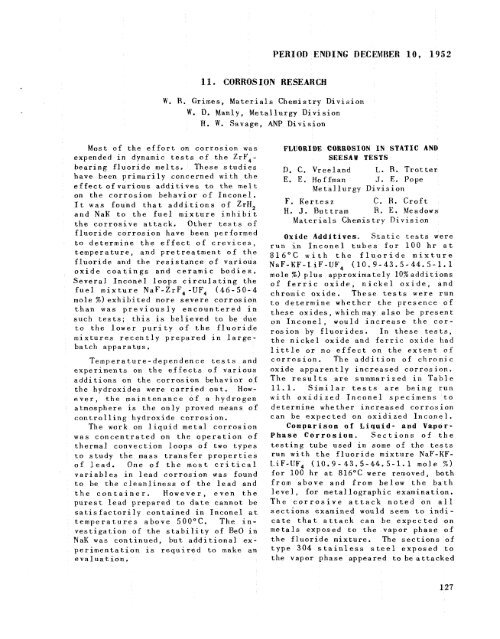the Molten Salt Energy Technologies Web Site
the Molten Salt Energy Technologies Web Site
the Molten Salt Energy Technologies Web Site
Create successful ePaper yourself
Turn your PDF publications into a flip-book with our unique Google optimized e-Paper software.
1 1. CORlROS ION RESEARCH<br />
PERIOD ENDING DECEMBER 20,<br />
W. R. Grises, Materials Chemistry Division<br />
Most of <strong>the</strong> effort on corrosion was<br />
expended in dynamic tests of <strong>the</strong> ZrF4-<br />
bearing fluoride me1 ts. These s tudies<br />
have been primarily concerned with <strong>the</strong><br />
effect of various additives to <strong>the</strong> melt<br />
on <strong>the</strong> corrosion behavior of Inconel.<br />
It was found that additions of ZrH,<br />
and NaK to <strong>the</strong> fuel mixture inhibit<br />
<strong>the</strong> corrosive attack. O<strong>the</strong>r tests of<br />
fluoride corrosion have been performed<br />
to determine <strong>the</strong> effect of crevices,<br />
temperature, and pretreatment of <strong>the</strong><br />
fluoride and <strong>the</strong> resistance of various<br />
oxide coatings and ceramic bodies.<br />
Several Tnconel loops circulating <strong>the</strong><br />
fuel mixture NaF-ZrF4 -UF, (46-50-4<br />
mole %)exhibited more severe corrosion<br />
than was previously encountered in<br />
such tests; this is believed to be due<br />
to <strong>the</strong> lower purity of <strong>the</strong> fluoride<br />
mixtures recently prepared in large-<br />
batch apparatus.<br />
Temperature-dependence tests and<br />
experiments on <strong>the</strong> effects of various<br />
additions on <strong>the</strong> corrosion behavior of<br />
<strong>the</strong> hydroxides were carried out. How-<br />
ever, <strong>the</strong> maintenance of a hydrogen<br />
atmosphere is <strong>the</strong> only proved means of<br />
controlling hydroxide corrosion.<br />
The work on liquid metal corrosion<br />
was concentrated on <strong>the</strong> operation of<br />
<strong>the</strong>rmal convection loops of two types<br />
to study <strong>the</strong> mass transfer properties<br />
of lead. One of <strong>the</strong> most critical<br />
variables in lead corrosion was found<br />
to be <strong>the</strong> cleanliness of <strong>the</strong> lead and<br />
<strong>the</strong> container. However, even <strong>the</strong><br />
purest lead prepared to date cannot be<br />
satisfactorily contained in Inconel at<br />
temperatures above 500°C. The in-<br />
vestigation of <strong>the</strong> stability of Be0 in<br />
NaK was continued, but additional ex-<br />
perimentation is required to make an<br />
e va 1 ua t ion,<br />
W. D. Manly, Metallurgy Division<br />
W. W, Savage, ANP Division<br />
FLUORIDE CORROSION IN STATIC AND<br />
SEESAW TESTS<br />
D. C, Vreefand L. R. Trotter<br />
E. E. Hoffman J. E. Pope<br />
Metallurgy Division<br />
F. Kertesz C. R. Craft<br />
H, J. Buttram R. E. Meadows<br />
Materials Chemistry Division<br />
1952<br />
Oxide Additives. Static tests were<br />
run in Inconel tubes €or PO0 hr at<br />
816°C with <strong>the</strong> fluoride mixture<br />
NaF-KF-LiF-UF4 (10.9-43.5- 44.5- 1.1<br />
mole X) plus approximately 10%additions<br />
of ferric oxide, nickel oxide, and<br />
chromic oxide. These tests were run<br />
to determine whe<strong>the</strong>r <strong>the</strong> presence of<br />
<strong>the</strong>se oxides, which may also be present<br />
on Inconel, would increase <strong>the</strong> cor-<br />
rosion by fluorides. In <strong>the</strong>se tests,<br />
<strong>the</strong> nickel oxide and ferric oxide had<br />
little or no effect on <strong>the</strong> extent of<br />
corrosion. The addition of chromic<br />
oxide apparently increased corrosion.<br />
The results are summarized in Table<br />
11.1. Similar tests are being run<br />
with oxidized Tnconel specimens to<br />
determine whe<strong>the</strong>r increased corrosion<br />
can be expected on oxidized Tnconel.<br />
Comparison of Liquid- and Vapor-<br />
Phase Corrosion. Sections of <strong>the</strong><br />
testing tube used in some of <strong>the</strong> tests<br />
run with <strong>the</strong> fluoride mixture NaF-KF-<br />
LiF-UF, (10.9-43.5-44.5-1.1 mole %)<br />
for 100 hr at 816°C were removed, both<br />
from above and from below <strong>the</strong> bath<br />
level, for metallographic examination.<br />
The corrosive attack noted on all<br />
sections examined would seem to indi-<br />
cate that attack can be expected on<br />
metals exposed to <strong>the</strong> vapor phase of<br />
<strong>the</strong> fluoride mixture. The sections of<br />
type 304 stainless steel exposed to<br />
<strong>the</strong> vapor phase appeared to be attacked<br />
127



![Review of Molten Salt Reactor Physics Calculations [Disc 2]](https://img.yumpu.com/21979492/1/190x247/review-of-molten-salt-reactor-physics-calculations-disc-2.jpg?quality=85)












